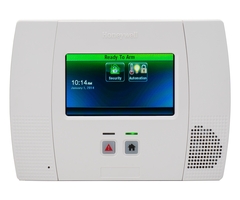Where should I place my LYNX Touch 5200?
There are varying philosophies on placement of a security system. Traditionally, wired system are located in a basement, attic or utility closet mainly because the system can be hidden since there are separate keypads used to control the system near the entry doors. Now with self-contained wireless alarm systems, like the Honeywell L5200 LYNX Touch, the alarm system circuitry is built into a touchscreen display keypad. Having the "brains" installed near an entry/exit delay door can be convenient for arming/disarming but also exposes a system to a possible "smash and grab" situation.
"Smash and grab" is an alarm industry term that refers to a situation where an intruder enters an armed premise and "smashes" or destroys the panel before the system is able to transmit signals to central station. There are a few different approaches to protecting your system from the danger of your system being compromised like this. The L5200, in particular, has a built-in technology called Advanced Protection Logic or APL. When paired with central station monitoring in our Basic Monitoring or Monitoring Plus+ plans, the L5200 will send a ping to the central station when the system is armed and an entry delay zone is faulted. The central station will hold that ping until the delay period expires. If they do not receive an alarm event or a disarm signal they know through the implementation of APL that the system has been compromised in some way. At this point, they will call and verify the alarm and dispatch the authorities if necessary. With this said, APL is a fail-safe solution that is best executed when paired with ideal placement of the the alarm panel.
There are several ways to arm your L5200. For example, you can use a wireless security key fob that are included in our security system kits. You may also have the Total Connect 2.0 service from which you can arm using a smartphone, tablet and/or computer. Lastly you can arm locally via the L5200 or an auxiliary keypad like the Honeywell 5828 or 5828V wireless keypad. Depending on your method of arming, the placement of the system will vary. Although across the board we recommend placing the L5200 in your master bedroom.
There are several reasons for installing the LYNX Touch in your bedroom. First, the L5200 siren should be within earshot in case of a break-in in the middle of the night or a fire alarm. The other reason relates back to our earlier points regarding protection against the "smash and grab." Having the system located further away from an entry/exit delay doors will give an intruder less time to locate and destroy the system.
Again, placement of your alarm system does hinge on the method of arming you chose. Our recommendation to place the system in the master bed is based on the assumption that you have entry delay zones. If you arm your system using a key fob or Total Connect and have all your zones set to perimeter the placement of the system is much more flexible. In fact, if you arm this way you can place the system where ever it is most convenient. Lastly, there is a desk mount option that makes it easy to move your system around as needed.
Did you find this answer useful?
We offer alarm monitoring as low as $10 / month
Click Here to Learn MoreRelated Products
Related Categories
- Answered
- Answered By
- Frank Longo




